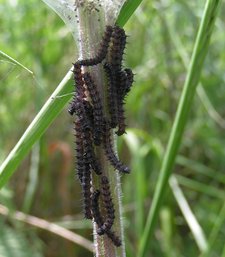Peacock (butterfly)
|
|
| Peacock | ||||||||||||||||||||||||||||||||
|---|---|---|---|---|---|---|---|---|---|---|---|---|---|---|---|---|---|---|---|---|---|---|---|---|---|---|---|---|---|---|---|---|
| Missing image Peacock_butterfly_heather.jpg Peacock butterfly on heather flowers | ||||||||||||||||||||||||||||||||
| Scientific classification | ||||||||||||||||||||||||||||||||
| ||||||||||||||||||||||||||||||||
| Binomial name | ||||||||||||||||||||||||||||||||
| Inachis io (Linnaeus, 1758) |
The Peacock (Inachis io) is a well-known colourful butterfly, found in temperate Europe and Asia. The species is resident in much of its range, often wintering in buildings or trees. It therefore often appears quite early in spring.
The butterfly measures about 5 cm (2 in) from wingtip to wingtip and is easily identified by its striking eye pattern on a ruddy background, although with wings closed the cryptically coloured underwings make it look like a dead leaf. The eyespots are reminiscent of those on the feathers of the peacock, hence the name. They are believed to be used to frighten predators (such as birds) by creating a false perception of a another predator (note how a glance at the image can give the impression of a cat staring).
The butterfly hibernates over winter before laying its eggs in early spring, in batches of up to 500 at a time. The caterpillars, which are shiny black with six rows of barbed spikes and a series of white dots on each segment, hatch after about a week and feed on nettles and hops. The adult butterflies feed on a wide variety of flowering plants, including buddleia, sallows, dandelions, wild marjoram, danewort, hemp agrimony, and clover; they also utilize tree sap and rotten fruit.
The Peacock can be found in woods, fields, meadows, pastures, parks, and gardens, and from lowlands up to 8,200 feet elevation. It is the commonest butterfly seen in parks and gardens in Europe.
Tagpfauenauge.jpg
da:Dagpňfugle°je de:Tagpfauenauge fr:Paon du jour nl:Dagpauwoog fi:Neitoperhonen lt:Spungė

